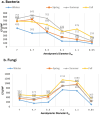Microbial indoor air pollution in Delhi Metropolitan City is attributable to severe respiratory and general health effects among residents
- PMID: 40777639
- PMCID: PMC12328385
- DOI: 10.3389/fpubh.2025.1626827
Microbial indoor air pollution in Delhi Metropolitan City is attributable to severe respiratory and general health effects among residents
Abstract
Indoor air quality plays a crucial role in the health and well-being of residents. Delhi, known as one of the most polluted cities globally, often receives insufficient attention in managing and mitigating related health impacts. This study isolated, characterized, and assessed microbial indoor air quality (bioaerosols) using multiproxy approaches and correlated findings with associated health effects. The spatial variation of bacterial aerosols showed irregular patterns, increasing from winter to summer and decreasing in fall; fungal aerosols consistently increased from winter to fall. Bacterial aerosol concentrations ranged from 730 to 5,300 CFU/m3, while fungal concentrations were between 1,330 and 6,050 CFU/m3, significantly exceeding the recommended limits. The size distribution of fungal aerosols varied across seasons, with higher concentrations in the 4th and 5th stages of the sampler. Several airborne bacterial and fungal genera, including Staphylococcus, Streptococcus, Micrococcus, Aspergillus, Penicillium, and Cladosporium, were identified in homes. Health effects were most pronounced in winter followed by fall, with symptoms such as headaches, eye irritation, allergic rhinitis, coughing, and sneezing being common. As per this study, there may be a correlation between indoor bioaerosol concentrations, seasonal variations, and health outcomes, though further in-depth in vitro, exposure assessment, and epidemiological studies are necessary to substantiate these findings.
Keywords: bacteria; fungi; indoor air quality; questionnaire survey; respiratory problems.
Copyright © 2025 Kumar and Singh.
Conflict of interest statement
The authors declare that the research was conducted in the absence of any commercial or financial relationships that could be construed as a potential conflict of interest.
Figures





Similar articles
-
Seasonal evaluation of culturable bioaerosols and airborne particulate matter in Iranian hospital wards using a Monte Carlo health risk model.Sci Rep. 2025 Jul 1;15(1):21952. doi: 10.1038/s41598-025-04182-2. Sci Rep. 2025. PMID: 40593985 Free PMC article.
-
Public health implications of bacterial and fungal bioaerosol concentrations in outdoor air.Sci Rep. 2025 Jul 2;15(1):22706. doi: 10.1038/s41598-025-08196-8. Sci Rep. 2025. PMID: 40593141 Free PMC article.
-
Indoor fungal diversity and asthma: a meta-analysis and systematic review of risk factors.J Allergy Clin Immunol. 2015 Jan;135(1):110-22. doi: 10.1016/j.jaci.2014.07.002. Epub 2014 Aug 23. J Allergy Clin Immunol. 2015. PMID: 25159468
-
Dynamics of fungal bioaerosols in Kuwait City: An 8-year survey.PLoS One. 2025 Aug 13;20(8):e0329318. doi: 10.1371/journal.pone.0329318. eCollection 2025. PLoS One. 2025. PMID: 40802603 Free PMC article.
-
Evaluation of exposure-response relationships for health effects of microbial bioaerosols - A systematic review.Int J Hyg Environ Health. 2015 Oct;218(7):577-89. doi: 10.1016/j.ijheh.2015.07.004. Epub 2015 Jul 18. Int J Hyg Environ Health. 2015. PMID: 26272513
References
-
- Swan J, Kelsey A, Crook B, Gilbert E. Occupational and environmental exposure to bioaerosols from composts and potential health effects: a critical review of published data In: Health and Safety Executive (HSE) research report, vol. 130 HSE Books; (2003)
MeSH terms
Substances
LinkOut - more resources
Full Text Sources
Medical
Research Materials

